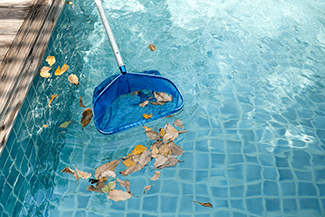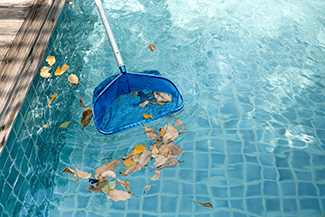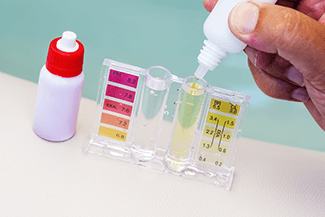The monsoon season’s combination of heat, rain, wind and dust storms can quickly make backyard swimming pools and spas turn green and murky.

A professional cleaning service likely comes once a week – and Murphy’s Law dictates that a storm will roll through the next day, undoing all the good work they have done. Now you have to wait a week before they come back. What do you do in the meantime?
Craig O’Grady, owner, Desert Sun Pools, a Rosie-Certified Partner, offers tips to keep Swamp Thing from moving into your swimming pool or spa.
“The most important thing is preventive maintenance,” says Craig. “Make sure your pool equipment is in good running order and that you keep your filters clean.”
Pool owners must remain proactive with their pools this time of year. He stresses that after the storm passes and it is safe to go outside, grab the net and clear the debris out of the pool to prevent the filtration system from becoming clogged. Keep the skimmer and pump baskets clean. Keep Chlorine on hand just in case you need it. One dust storm will deplete the chlorine levels fast.
Craig offers these steps to keep your pool sparkling clean.
1 | Skim the surface.

Routinely use a long-handled skimming net to clean the water’s surface of floating pollen, bugs, and debris before it sinks to the bottom of the pool.
2 | Brush away dirt.
Use a long-handled brush to loosen dirt, algae, and calcium deposits from the sides and bottom of the pool. Avoiding the buildup of algae and calcium on your pool’s surface and tile is critical for the health of your pool and prevents damage to the surface. Remove stubborn calcium deposits with a pumice stone.
3 | Vacuum your pool weekly.
The cleaner your pool is, the less often you will need chemicals to treat the water. If your pool vacuum cleans automatically, make sure the wheels are moving properly and the unit is traveling freely along the bottom and up the sides. Check the pool hose often for kinks that can hinder proper suction. If the hose is floating, it may have a hole and need to be replaced.
4 | Empty the plastic strainer baskets.

They can become clogged with leaves, rodents, and other debris that can hinder water circulation water and affect the chemical balance.
5 | Monitor the water level.
Water evaporates, and kids splash. If the water level falls below the skimmer basket line, add water to avoid damaging the pump. If your pool has automatic water leveling and the water level is still low, it may need maintenance or repair.
6 | Check the pH level.
When water chemicals are out of balance, it can cause skin and eye irritation and damage pool equipment. The pH scale from 0-14 measures acidity or alkalinity in the water. Your water should remain between 7.2 and 7.8 for optimal balance. You can easily monitor the pH level with simple testing strips that change color when dipped in the pool water. The strip’s color is matched to a color chart that determines the pool’s pH level. Or, use a Reagent’s kit that uses tablets to dye a sample of the pool water. The color determines the pH level and type of chemicals needed to bring it back into balance. Kits are available at pool supply and most home improvement stores. If you want a professional opinion, bring a sample to your neighborhood pool supply store. Most stores will test it for free.
7 | Shock it.

If your pool is cloudy, “shock” it with a super-chlorination treatment which quickly raises the chlorine level and kills off the algae. Let the pump run for a minimum of six to eight hours after adding shock, then retest the water’s chemistry.
8 | Clean the pool filter.
Follow your equipment manufacturer’s recommendations for cleaning the filter properly. The recommendations will vary depending on the type you have; cartridge, sand, or diatomaceous earth filters. Your pool builder will recommend the best system for you. The filter must be cleaned regularly. How often depends on the weather and the amount of surrounding landscaping that regularly falls into the pool. Check the pressure gauge and flow meter to determine if the filter needs cleaning. Clean the filter when the difference reaches 10 to 15 pounds (4.5 to 6.8 kilograms) per square inch. If you are unsure, call a professional pool service technician to help you.
Clearing away debris and dirt between professional cleanings will allow you to enjoy your pool throughout the season.
Home Maintenance To-Do: #MonsoonPoolCare
###
PODCAST
Tune-In below for a great ‘Aging In Place’ segment on how scammers prey on the elderly and how to avoid being scammed. The Weekly To Do on pool maintenance during monsoon season with Desert Sun Pools’ Craig O’Grady. ABC15 Meteorologist Iris Hermosillo explains why the storm that hit Scottsdale was so intense with rain, near hurricane force winds and constant lightning. Plus why you should keep your A/C fan motor on ‘auto’.
















